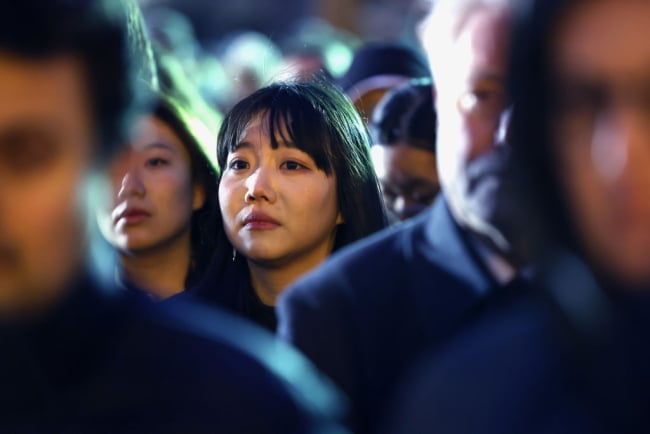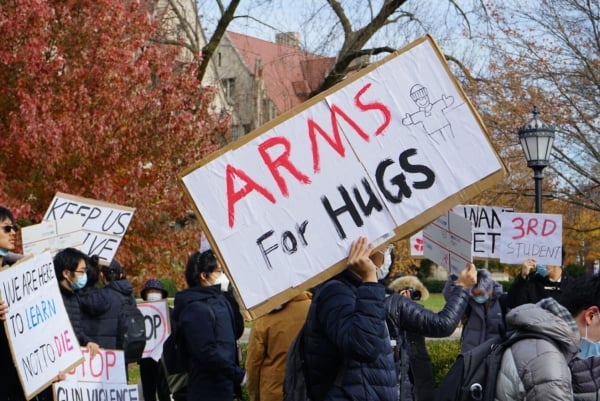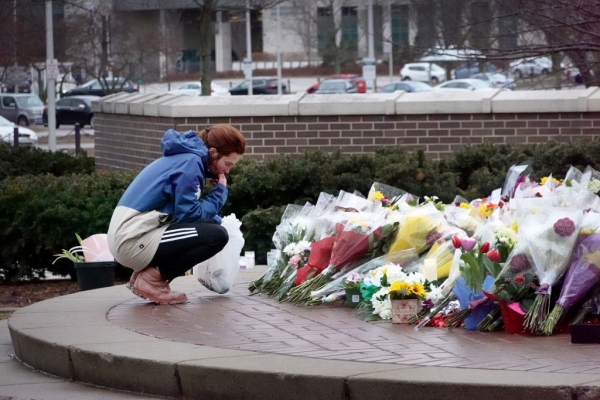You have /5 articles left.
Sign up for a free account or log in.

Students at MSU gather for a vigil the night after a mass shooting left three classmates dead and more injured, including two international students. The tragedy underscored the growing concern over U.S. gun violence among international applicants.
Scott Olsen/Getty Images
When Zhenyang Xu, a second-year international Ph.D. student at Michigan State University, first received the alert that there was an active shooter on campus, he barely thought twice about it.
“I looked at my phone and I just thought, ‘Oh, OK. Another one,’” he said. “It’s so normalized here and we get so much news about shootings that I didn’t notice it was something entirely different and scarier until more alerts started coming.”
Three students were killed and another five were injured in the Feb. 13 shooting at Michigan State, including two international students from Xu’s native China—one of whom, 20-year-old John Hao, was paralyzed from the neck down. Xu said the tragedy was a wake-up call, an all-too-visceral reminder that the plague of gun violence he’d read about in the news was a frightening reality in the country where he’d chosen to study.
The fear of being caught in a mass shooting like the one at MSU has become a major factor in international students’ decisions about whether to study in the U.S. According to a fall 2018 survey by the Institute of International Education, the issue with the biggest year-over-year increase in concern among international applicants in 2017–18—a year in which U.S. institutions saw a decline in international enrollment—was their “physical safety in the U.S.”
It’s also a daily concern for many international students already studying in America: according to a 2019 survey by the World Education Services, a quarter of international students in the U.S. expressed worry about gun violence at their institution; that number jumped to 37 percent when they looked at their college’s broader host community.
Rajika Bhandari, an independent consultant on international education research and strategy, said that in recent years fears about gun violence and personal safety have eclipsed other perceived drawbacks of studying in the U.S.
“In broad global surveys, when students have been asked about the downsides of going to the U.S., we’ve seen the lack of personal safety rise to the top,” she said. “Before it was primarily about cost and visa hurdles, which of course are still there; it’s just that personal safety has really become quite magnified.”
The gun violence driving these fears has not abated; in the past few months alone, campus shootings have dominated headlines. In October, a University of Arizona professor was murdered by a former student; the next month, three University of Virginia football players were shot and killed on their team bus, allegedly by a classmate. The February mass shooting at Michigan State exacerbated the concerns of international families since the gunman injured two of their own.

Andres Yang/The Chicago Maroon
It’s not just campus shootings driving safety fears. In November 2021, Shaoxiong Zheng, a Chinese international student at the University of Chicago—a dream destination for many international students—was shot and killed in a street robbery. A week later, hundreds of students, many of them international, marched across campus to call for stricter gun legislation, holding signs reading, “We’re here to learn, not to die” and “Who’s next?”
Jenny Lee, a professor of educational policy studies at the University of Arizona, said international students and their families are haunted by the fact that foreign-born victims of gun violence took a risk in choosing to study in America.
The question, Bhandari said, is whether they will decide that risk has become too great.
“This is usually a family decision, whether and where to study abroad, and safety really matters … Gun violence has definitely impacted that decision-making matrix,” she said. “It’s the 800-pound gorilla in the room.”
A Major Issue in Asia, Especially China
The 2019 WES survey found not only that international students in the U.S. were concerned about gun violence but also that some were more concerned than others. Only 25 percent of students from Latin America and 32 percent from Europe said they were worried about gun violence, compared to upward of 40 percent from South Asia and East Asia.
Students from Asia are the largest contingent of international students studying in the U.S. by region, and more come from China than any other country. But that could soon change: according to the 2022 IIE Open Doors report, Chinese international student enrollment fell by 9 percent in 2021–22, after a 15 percent drop in 2020–21.
Plenty of factors besides gun violence have contributed to this decline, Lee said. Under the Trump administration, anti-Asian racism played a role; those concerns grew more prevalent during the COVID-19 pandemic, when Asian Americans were targeted in a series of violent crimes from New York to Atlanta. Another perennial issue is the increasingly difficult visa process between the two countries, exacerbated by the erosion of the bilateral U.S.-China relationship.
But Lee said gun violence has remained a constant in the shifting collage of concerns. She chalks this up to the rarity of guns in China and other Asian countries.
“In Asia in particular, it’s not just hard to obtain a gun; you don’t really ever see them. Not even the police carry guns in many Asian countries,” she said. “So that general sense of unease around guns is heightened.”
Mark Ashwill, an independent contractor who recruits international students for Western schools, said the same was true in Vietnam, where he lives and works.
“In Vietnam, like most countries, you aren’t even allowed to own a handgun. Only the police and military are,” he said. “It’s a nonissue here.”
Xiaofeng Wan, associate dean of admissions and international recruitment coordinator at Amherst College, is no stranger to the fears of his international recruits. He arrived in the U.S. from China in 2011 as an international student himself, bound for a master’s program in higher education administration at Boston College; he said that even then, gun violence was on his and his family’s mind.

Scott Olsen/Getty Images
Those concerns have become more pronounced since, Wan said. He often combs Chinese social media sites and newspapers, and he said that headlines about U.S. gun violence—especially incidents on college campuses or in which Asian people are victims—inspire a frenzy of public concern, particularly among parents who are at least considering sending their children to the U.S. for college.
Wan also said that Chinese consulates commonly issue warnings after gun violence incidents—as they did after the MSU shooting—prompting a barrage of cautionary messages and articles on Chinese social media sites and in state-run news outlets.
“People in China do read and hear about these shootings; they are very aware,” Wan said. “News cycles come and go, but this issue never really leaves families’ minds. Once it happens, it remains a major concern.”
Wan said his parents text him to make sure he’s safe every time there’s a shooting in the country—even if it takes place in Texas or California, hundreds of miles from his small Western Massachusetts college town. That attitude, he said, is fairly common, and not just for parents of American residents.
“They are kind of a symbol for how the general Chinese public views this issue,” he said. “No state is safer than another; if you’re in the U.S., you are in danger of getting shot.”
An Opening for Competition
The U.S. has long been the top destination for international students in the world, and it remains solidly so; nearly a million international students were enrolled at U.S. institutions in 2022, according to the IIE report.
But there are plenty of competitors eager to poach chunks of that lucrative pool from the U.S. market. The U.K. remains a top destination for international students. Others are looking at colleges in Canada, which has seen interest from abroad skyrocket in recent years; in 2022 alone, international student enrollment in Canadian institutions increased by 24 percent over the previous year.
“Canada has really risen to the top, and there are many reasons for that, but one is that you just don’t hear as much about Canada being a place that is not safe,” Lee said. “Yet you still have top world-class institutions, you have an English-speaking country—all the things the U.S. offers without the personal-safety baggage.”
The rate of gun violence deaths in the U.S. is eight times higher than Canada’s and nearly 100 times higher than the U.K.’s, according to 2019 data from the University of Washington’s Institute for Health Metrics and Evaluation.
Before arriving at MSU two years ago, Xu got his master’s at the University of British Columbia in Vancouver. He said his decision was partly influenced by what he’d heard about violence and racism in the U.S.
“A lot of international students at UBC did talk about choosing Canada because they felt it was safer there,” Xu said. “And when we were recruiting Ph.D. students [at MSU] and the shooting happened, two of them from China did call me and ask me, frankly, ‘Do you think it’s still safe there?’”
But Ashwill said for many prospective international students, the upside of going to college in the U.S. still outweighs the safety risks.
“Safety is a selling point for sure, but it’s not a deal breaker for most students or even parents,” Ashwill said. “I find that most families I talk to view it as a kind of cost-benefit analysis, and for most the benefits are still outweighing the risks.”
Xu agreed, but said that, at least in his native China, the issue of gun violence was in danger of disrupting that calculus.
“Most families really care more about the prestige and quality that you get [in the U.S.], and so I don’t think guns are really going to make [international] enrollment decline,” he said. “But if things seem to get more dangerous, that’s going to be a big concern for parents and could have a real effect.”









